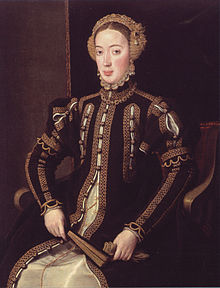Maria of Portugal, Duchess of Viseu
| Maria of Portugal | |
|---|---|
| Duchess of Viseu | |

Anthonis Mor (c. 1550-1555)
|
|
| Born | 18 June 1521 Lisbon, Kingdom of Portugal |
| Died | 10 October 1577 (aged 56) Lisbon, Kingdom of Portugal |
| Burial | Church of Our Lady of Luz, Lisbon |
| House | House of Aviz |
| Father | Manuel I of Portugal |
| Mother | Eleanor of Austria |
| Religion | Roman Catholicism |
D. Maria of Portugal, Duchess of Viseu (18 June 1521 – 10 October 1577 in Lisbon; Portuguese pronunciation: [mɐˈɾiɐ]) was an Infanta of Portugal, the only daughter of King Manuel I of Portugal and Eleanor of Austria. A noted patron of the arts, Maria's personal wealth rivaled that of the king, her brother (John III of Portugal), making her the richest woman in Portugal and one of the richest in Europe.
Maria was born on June 18, 1521 in Lisbon. In December the same year, her father died and her half-brother John III became king. Shortly afterwards, Maria's mother, the dowager queen Eleanor, returned to her brother's court in Vienna, taking Maria with her.
In 1530, Eleanor married King Francis I of France and moved to France. Maria would not see her mother for nearly 28 years. Meanwhile, in 1525, Eleanor's younger sister (Maria's aunt) Catherine had married Maria's half-brother John III of Portugal. At some point, Maria moved from Vienna to Lisbon. She was to live in Portugal, at the court of her half-brother and his family, for the rest of her life.
In 1537 Maria was briefly considered, along with her cousin Christina, Dowager Duchess of Milan, as a bride for Henry VIII. However, Christina was considered more suitable, and England dropped any pursuit of Maria. She was at one point considered as a second wife for her nephew and cousin (the future Philip II of Spain). Philip was the son of Maria'a half-sister Isabella of Portugal. Also, Maria's mother, Eleanor, and Philip's father, Charles V, were siblings. The matter was taken to serious consideration from 1549 onward, when her mother, the queen dowager Eleanor of France, settled in Brussels and started to support them. However, these plans were discontinued when Mary Tudor succeeded to the English throne in 1553, and the Emperor Charles V decided to marry his son Philip to her.
...
Wikipedia
